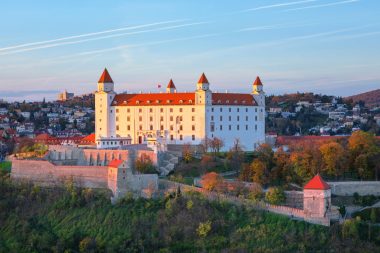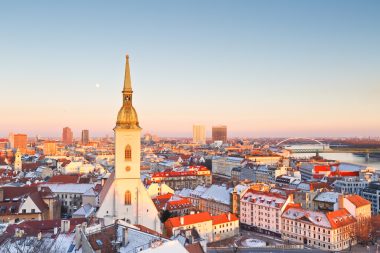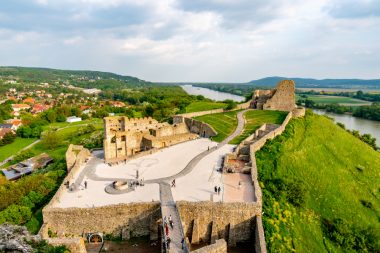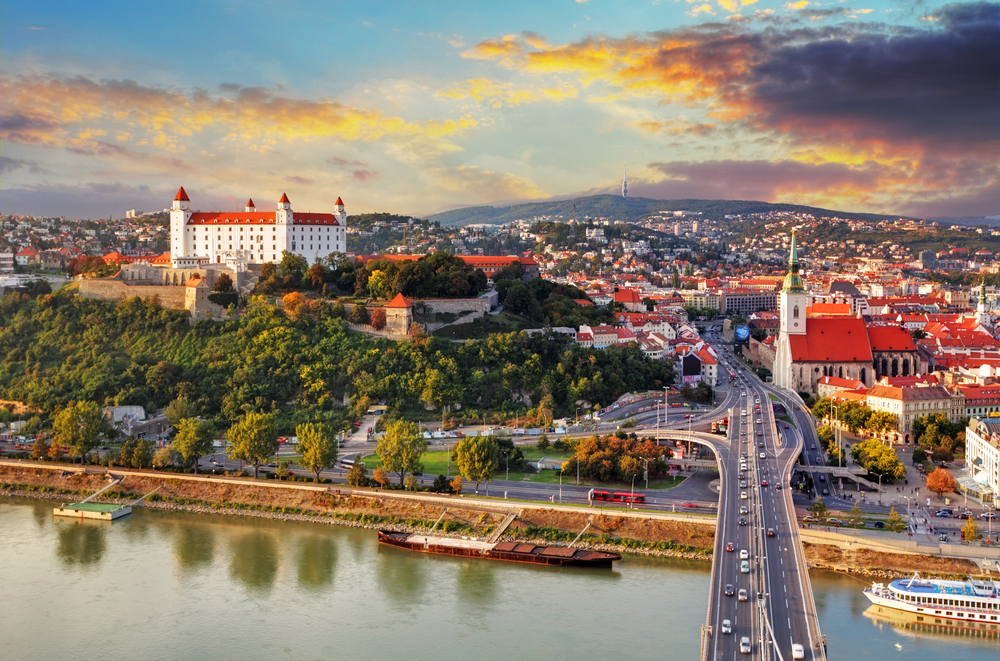Similar to Vienna , Bratislava is also known for its coffee house culture. In addition, the city impresses with its many romantic corners, street artists and the historic center.
The capital of Slovakia has been shaped by many cultures over time. First the Celts, Romans and Germanic tribes, later the Germans, Hungarians and of course the Slovaks. During the reign of Maria Theresa, the city gained its greatest importance.
During the socialist era, Bratislava was also characterized by communist buildings. These were painted in color after the fall of the Berlin Wall to give the city a friendlier appearance. Another initiative to make the city look livelier and more interesting are the many statues that can be found all over the old town. Hidden in the crowd, they are just waiting to find new admirers.
Sights in Bratislava and its surroundings
Bratislava Castle

This historic building is the symbol of Bratislava. The mountain was already inhabited in the Stone Age and in the 13th century the foundation walls for today’s complex were laid. Most of the castle building itself dates back to the 15th century. In 1811, the complex burned down and it was not until a good hundred years later that it was renovated.
Today, however, the castle shines white over the city as it did in the old days. Inside are the crown jewels of the Hungarian kings, for whom this castle was a residence. The treasure chamber is also open to visitors.
In summer, numerous cultural events take place on the castle grounds. So you are invited to theaters, craft markets and concerts.
Bratislava TV Tower
This tower from 1975, built at a height of 433 meters, is itself 194 meters high and thus holds the record in Slovakia.
Due to the high transmission power, the Slovakian radio stations can still be received in Vienna, 80 km away, without any problems.
At a height of 68 meters, it also houses a restaurant, from which you can enjoy a wonderful panoramic view over Bratislava, as far as Austria and Hungary. The main restaurant also offers a comfortable 360° view, as the tables are located on a turntable.
St. Martin’s Cathedral

This cathedral – also called “Cathedral of Saint Martin” – was dedicated to Saint Martin of Tours. He is considered the founder of Western monasticism and is the national patron saint of Slovakia.
Construction of the cathedral began as early as the 13th century. However, the church consecration did not take place until 10 March 1452. The main reason for the delay was both deficiencies in financing and the difficult construction of the central nave. In the years after its completion, the choir was further enlarged and the cathedral was supplemented by the St. Anna Chapel and the Chapel of Queen Sophia.
Maximilian II was the first Hungarian king to be crowned in St. Martin’s Cathedral in 1563. He was followed in the following years by eleven more kings and eight queens until 1830.
The Baroque had not left the cathedral unscathed in all this time, but in the middle of the 19th century efforts were made to restore the building to its original Gothic state. Thus, the cathedral can still be seen today in its presumed original appearance.
St. Elisabeth’s Church
St. Elisabeth’s Church is a nice change of color. Fittingly, it is also called the Blue Church. Their color comes from a blue mayolical mosaic.
The Hungarian architect Ödön Lechner designed the church in forms of Hungarian Art Nouveau and if you look closely, you can see that both the parish and the grammar school behind it were designed by the same pen.
The blue colour continues to dominate the interior of the church and pictures decorate the walls. Above the altar is a picture of St. Elizabeth of Hungary, to whom the church is dedicated.
Thebes Castle

In the Devín district of Bratislava stands Thebes Castle (or Devín). Today it is only a ruin, but for the Slovaks it is an important part of their cultural history.
While the location of the castle had already been used by the Romans as a strategically advantageous position before our era, the castle was not mentioned in writing until 864 AD.
Since 1961, the ruins have been listed as historical monuments and are now an open-air museum that not only invites visitors to immerse themselves in the Slavic past, but also offers a panoramic view over the Danube and March.
Čumil
One of the statues mentioned above is the Čumil, the gaffer. If you walk past the shop windows of the center, you should rather pay attention to the floor. Because there the Čumil looks out of a manhole cover.
There are various explanations for the bronze figure: Either it is a sewer worker resting from work, or a worker who takes the opportunity to peek under the women’s skirts.
Whatever the truth, Čumil is without a doubt one of the most popular photo opportunities in Bratislava.
Museums in Bratislava
In Bratislava, the capital of Slovakia, there are a variety of museums that offer visitors insights into various aspects of the history, art and culture of the city and the country. Here are some museums in Bratislava:
- The Slovak National Museum: The Slovak National Museum is the oldest and largest museum in Slovakia. It consists of several departments and exhibition venues throughout the city, including the Historical Museum, the Archaeological Museum, the Museum of Natural Sciences and the Museum of Music.
- The Bratislava City Museum: The Bratislava City Museum is dedicated to the cultural heritage of the city. It features exhibitions on the history of Bratislava, including archaeological finds, historical artifacts, and information about the city’s development.
- The Museum of Modern Art (Danubiana Meulensteen Art Museum): The Museum of Modern Art is located on a peninsula on the Danube, just outside Bratislava. It houses an impressive collection of contemporary artworks by Slovak and international artists.
- The Museum of the City of Bratislava: The Museum of the City of Bratislava is located in the Old Town Hall in the historic center of the city. It presents exhibitions on the history of Bratislava and displays artifacts, paintings, and models that illustrate the development of the city over the centuries.
- The Devin Castle Museum: The Devin Castle Museum is located in the ruins of Devin Castle, which towers high above the Danube, about 10 kilometers outside of Bratislava. The museum offers insights into the history of the castle and the region, as well as archaeological finds from the surrounding area.
Facts about Bratislava
- Geographical location: Bratislava is located in the extreme southwest of Slovakia, on the border with Austria and Hungary. It is the only capital city in the world that borders more than one neighboring country.
- Danube: The city is located on the Danube, one of the longest rivers in Europe. The Danube connects many countries and cultures and is an important part of Bratislava’s cultural and economic life.
- Population: The city has about 440,000 inhabitants (as of 2021).
- Historical significance: Bratislava has a rich history. It was once the coronation city of the Kingdom of Hungary, and many kings and queens have been crowned in St. Martin’s Cathedral.
- Architecture: The city has a mix of medieval and modern architecture. Among the most notable buildings are Bratislava Castle, the Old Town Hall and the Primate’s Palace.
- Languages: The official language is Slovak, but many residents also speak English, German and Hungarian.
- Economy: Bratislava is the economic heart of Slovakia. Many multinational companies are based in the city, especially in the fields of information technology, pharmaceuticals and automotive manufacturing.
- Education: Bratislava is home to several universities and colleges, including Comenius University, the oldest surviving university in Slovakia.
- Tourism: Bratislava is a popular tourist destination. Some of the most popular attractions include the Old Town, Bratislava Castle, Devin Castle, and the Blue Church.
- Culture: Bratislava is a center of culture with many theaters, museums, galleries and music festivals. The city also hosts the Bratislava Music Festival, one of the oldest music events in Europe.


